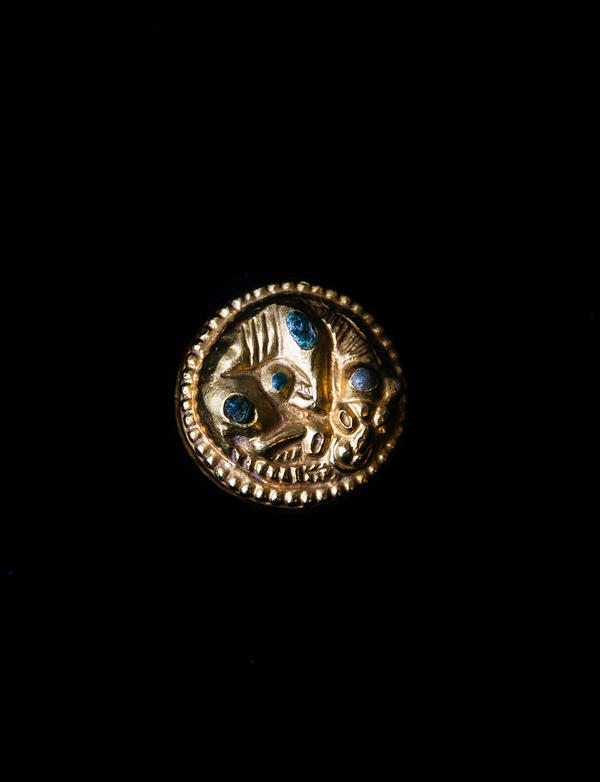Phalerae are round discs for decorating horse harnesses and distributing harness belts. It covered the intersections of the belts. Most likely, the exhibit from our collection was crafted at the ancient sites of the East.
The phalera is made of bronze, while its edge is decorated with a gold plating glued to the base with a dark resinous substance. There is also an eye soldered to the base. A craftsman used a chisel to refine the smallest details of the ornament.
There is a panther curled up in a ball in the middle of the phalera. Its thigh, shoulder bone, ears, eyes and paw are decorated with inserts of blue, green, brown transparent glass and gray glass paste. The fur on the mane and ribs are marked with lines, and its tail ends with a fir tree-shaped tassel.
Totemism was widespread in the Sarmatian animal style: animals were indued with certain qualities and compared with people. The beast-predator personified the warrior and, respectively, was considered as the patron saint of military affairs. According to ancient legends, an amulet or even just an image of a totem animal inspired certain qualities in a person. For example, someone may be indued with strength, dexterity, or wisdom.
The static images of predatory animals are also presented in the Scythian-Sarmatian culture as an addition to dynamic scenes of torments. Certain animals personified various phenomena: peace, rest, sacrifice and even death. As for our phalera, the figure of a curled up animal depicted by an ancient author may symbolize the eternal movement of the universe, and the cyclical nature of life. There is a row of styled ‘pearls’ around the animal along the edge of the phalera. The pearls were made with a punch, a special tool that made it possible to apply a dotted pattern.
The phalera was found in 1964 on a mound near ZhUtovo station by the Astrakhan archaeological expedition arranged by Leningrad branch of the Institute of Archeology of the USSR Academy of Sciences and led by ValentIn ShIlov.
In 2005, the item and other valuable finds were exhibited at the Astrakhan Steppe Treasures show at the National Museum of the Palazzo Venezia in Rome. In 2008, it was presented at the Gold of the Sarmatians show at the State Historical Museum in Moscow.
The phalera is made of bronze, while its edge is decorated with a gold plating glued to the base with a dark resinous substance. There is also an eye soldered to the base. A craftsman used a chisel to refine the smallest details of the ornament.
There is a panther curled up in a ball in the middle of the phalera. Its thigh, shoulder bone, ears, eyes and paw are decorated with inserts of blue, green, brown transparent glass and gray glass paste. The fur on the mane and ribs are marked with lines, and its tail ends with a fir tree-shaped tassel.
Totemism was widespread in the Sarmatian animal style: animals were indued with certain qualities and compared with people. The beast-predator personified the warrior and, respectively, was considered as the patron saint of military affairs. According to ancient legends, an amulet or even just an image of a totem animal inspired certain qualities in a person. For example, someone may be indued with strength, dexterity, or wisdom.
The static images of predatory animals are also presented in the Scythian-Sarmatian culture as an addition to dynamic scenes of torments. Certain animals personified various phenomena: peace, rest, sacrifice and even death. As for our phalera, the figure of a curled up animal depicted by an ancient author may symbolize the eternal movement of the universe, and the cyclical nature of life. There is a row of styled ‘pearls’ around the animal along the edge of the phalera. The pearls were made with a punch, a special tool that made it possible to apply a dotted pattern.
The phalera was found in 1964 on a mound near ZhUtovo station by the Astrakhan archaeological expedition arranged by Leningrad branch of the Institute of Archeology of the USSR Academy of Sciences and led by ValentIn ShIlov.
In 2005, the item and other valuable finds were exhibited at the Astrakhan Steppe Treasures show at the National Museum of the Palazzo Venezia in Rome. In 2008, it was presented at the Gold of the Sarmatians show at the State Historical Museum in Moscow.



